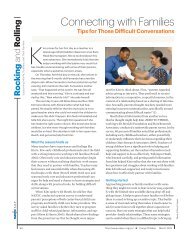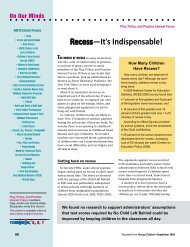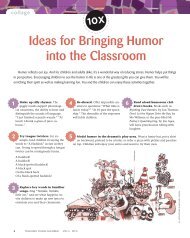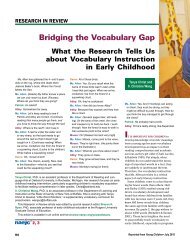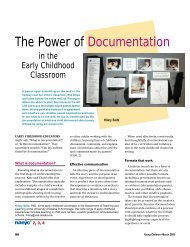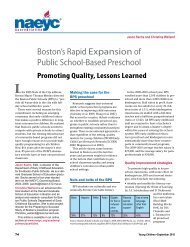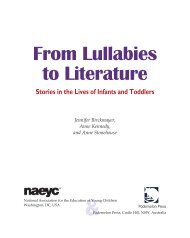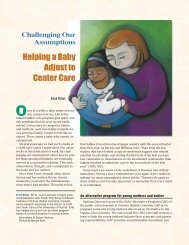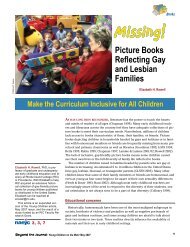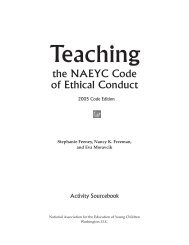Understanding Families - National Association for the Education of ...
Understanding Families - National Association for the Education of ...
Understanding Families - National Association for the Education of ...
You also want an ePaper? Increase the reach of your titles
YUMPU automatically turns print PDFs into web optimized ePapers that Google loves.
If conferences with <strong>the</strong> family don’t illicit a response that<br />
allows Nancy to address <strong>the</strong> change in <strong>the</strong>ir behavior, she<br />
may choose to directly state her concern that she has<br />
<strong>of</strong>fended <strong>the</strong>m in some way. She may ask <strong>for</strong> <strong>the</strong>ir help in<br />
understanding so that she will not repeat her mistake and<br />
stress how much she values and respects <strong>the</strong> family as<br />
part <strong>of</strong> her classroom. She may communicate to <strong>the</strong>m how<br />
vital <strong>the</strong>y are to <strong>the</strong> success <strong>of</strong> <strong>the</strong> program and especially<br />
to <strong>the</strong>ir children. She may also ask if <strong>the</strong>y have a need that<br />
she has failed to address.<br />
Ideas <strong>for</strong> working with families—Hierarchy<br />
1. Engage in careful and keen observation. “Family<br />
watching” is essential. Who signs <strong>the</strong> permission <strong>for</strong>ms?<br />
Who returns <strong>the</strong> phone call? How does <strong>the</strong> child role-play<br />
his family members in dramatic play? Does a youngster<br />
assume that a male teacher is <strong>the</strong> boss <strong>of</strong> <strong>the</strong> female<br />
teachers? While answers to <strong>the</strong>se<br />
questions are not always indicative<br />
<strong>of</strong> hierarchy, <strong>the</strong>y may <strong>of</strong>fer clues.<br />
2. Note <strong>the</strong> signs that a family’s<br />
hierarchy is in <strong>the</strong> process <strong>of</strong><br />
changing. Be aware that children<br />
can respond by testing hierarchy in<br />
<strong>the</strong> classroom. A child who <strong>of</strong>ten<br />
leads at school may appear lost or<br />
unsure <strong>of</strong> herself as a new stepbro<strong>the</strong>r<br />
takes her place “in charge”<br />
<strong>of</strong> younger siblings. Help her to<br />
reclaim her confidence through<br />
activities that allow her to experience<br />
success.<br />
3. Watch out <strong>for</strong> hierarchies<br />
emerging in <strong>the</strong> classroom and on<br />
<strong>the</strong> playground. While hierarchy<br />
can lead to a sense <strong>of</strong> order and<br />
security, it can also lead to a pecking<br />
order and in <strong>the</strong> worst cases,<br />
bullying. Avoid activities that rein<strong>for</strong>ce<br />
<strong>the</strong> same hierarchy over time.<br />
Vary activities so that different<br />
children’s strengths are showcased.<br />
Climate<br />
Climate is about <strong>the</strong> emotional and physical environments<br />
a child grows up in. Some families compensate <strong>for</strong><br />
hurtful or inadequate parts <strong>of</strong> <strong>the</strong> environment, such as<br />
living in a dangerous neighborhood, as best as <strong>the</strong>y can<br />
(Nieto 2004). O<strong>the</strong>r families have <strong>the</strong> best that money can<br />
buy, but <strong>the</strong> emotional quality <strong>of</strong> <strong>the</strong> home environment is<br />
not optimal <strong>for</strong> <strong>the</strong> children. The culture, economic status,<br />
or educational level <strong>of</strong> <strong>the</strong> family does not cause <strong>the</strong><br />
emotional quality <strong>of</strong> <strong>the</strong> environment to be positive or<br />
<strong>Families</strong><br />
negative. Emotional quality is related to beliefs about<br />
children and families. To determine <strong>the</strong> climate <strong>of</strong> a family<br />
system, consider <strong>the</strong> answers to <strong>the</strong> following questions:<br />
What would it feel like to be a child in this family? Would I<br />
feel safe, secure, loved, encouraged, and supported? Or<br />
would I feel scared, fearful, angry, hated, and unhappy?<br />
Ideas <strong>for</strong> working with families—Climate<br />
1. Provide opportunities <strong>for</strong> families to discuss <strong>the</strong>ir<br />
beliefs about children, what <strong>the</strong>y want <strong>for</strong> <strong>the</strong>ir children,<br />
and how <strong>the</strong>y support <strong>the</strong>ir children’s development. Staff<br />
can facilitate at <strong>the</strong> events. These discussions help teachers<br />
learn how <strong>the</strong>y can best support families as <strong>the</strong> families<br />
support <strong>the</strong>ir children (Delpit 1995; Garcia 2001). An<br />
additional benefit is that families <strong>of</strong>ten value in<strong>for</strong>mation<br />
and advice from <strong>the</strong>ir peers more than through a lecture<br />
on good<br />
parenting.<br />
Climate is about<br />
<strong>the</strong> emotional and<br />
physical environments<br />
a child grows up in.<br />
2. Create a<br />
classroom<br />
climate <strong>of</strong><br />
safety, positive<br />
feedback<br />
and guidelines,<br />
and<br />
healthy sensory<br />
experiences. Even<br />
if home environments do<br />
not <strong>of</strong>fer <strong>the</strong>se (or especially!),<br />
children need to<br />
feel school is a wonderful<br />
place to be.<br />
Equilibrium<br />
It is critical <strong>for</strong> early<br />
childhood pr<strong>of</strong>essionals<br />
to understand <strong>the</strong> balance<br />
or sense <strong>of</strong> equilibrium<br />
within a family.<br />
Changes or inconsistency<br />
in a family can<br />
create confusion or<br />
resentment in its members, including children (Kern &<br />
Peluso 1999). Consistency in families can be difficult to<br />
maintain, but it is essential to children’s development <strong>of</strong> a<br />
sense <strong>of</strong> security and trust. Rituals and customs <strong>of</strong>ten<br />
keep a family toge<strong>the</strong>r during times <strong>of</strong> change and stress<br />
(Fingerman & Bermann 2000). All families, even ones with<br />
ongoing difficulties, have a sort <strong>of</strong> balance that tells members<br />
what to expect. When <strong>the</strong>re is change, positive or<br />
negative, it impacts <strong>the</strong> balance <strong>of</strong> <strong>the</strong> family. That is one<br />
reason change is so difficult to maintain.<br />
Beyond <strong>the</strong> Journal Young Children on <strong>the</strong> Web January 2006 7<br />
© Skjold Photography





